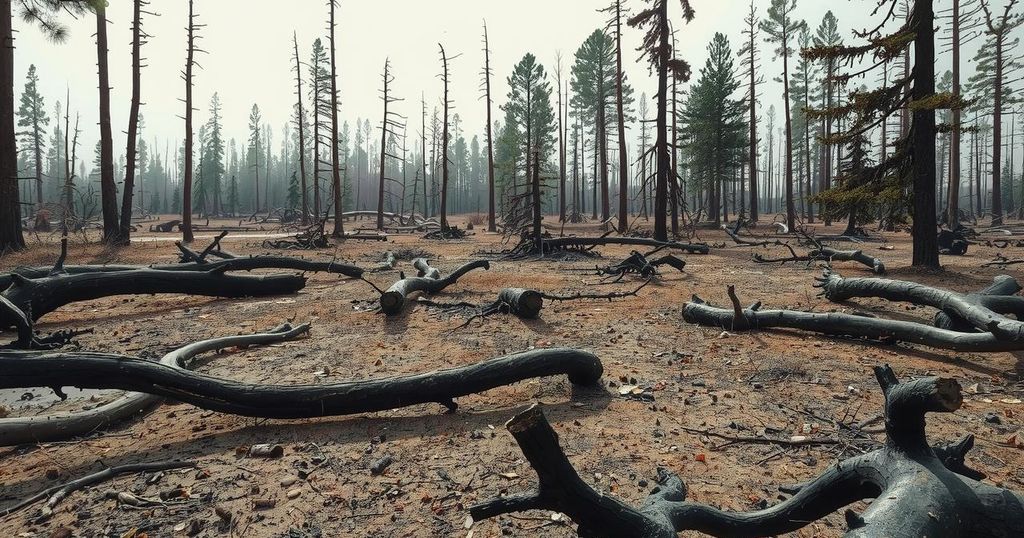Hurricane Helene’s aftermath has increased wildfire risks in certain regions of the U.S., as downed debris serves as fuel. Michele Steinberg from the NFPA highlights the importance of understanding wildfire conditions and taking preventive actions. Meanwhile, an above-average hurricane season is predicted for 2025, stressing the need for preparedness.
Last fall’s Hurricane Helene inflicted remarkable devastation across Southwest Virginia, Northeast Tennessee, and Western North Carolina. Communities are still engaged in cleanup efforts months later, as the effects of the storm have led to increased wildfire risks in the region. Michele Steinberg, the Wildfire Division Director at the National Fire Protection Association (NFPA), emphasizes that the debris resulting from Helene is altering patterns and elevating wildfire hazards.
Steinberg points out that while wildfires can be destructive, they also play a beneficial role in ecosystems. Seasonal fires contribute to returning nutrients to the soil, eliminating dead growth, and fostering the growth of specific plant species. This natural cycle means that trees, grasses, and shrubs serve as fuel for fires, particularly during the spring and fall seasons when fire conditions are heightened in the Northeast, Mid-Atlantic, and Southern states.
The fuel for wildfires in these regions is often present even when snow remains on the ground, as the accumulation of dead materials becomes dry. When sunny and windy conditions occur, the likelihood of wildfires increases significantly. Unfortunately, in developed areas, homes and cars can turn into fuel sources during wildfires, increasing the danger to local communities.
Following hurricanes, like Helene, considerable amounts of greenery are displaced, adding to the available fuel for potential wildfires. The aftermath of such storms complicates fire management, as efforts often prioritize restoring infrastructure over addressing fire risks. Steinberg highlights that the excessive amount of dead material hampers natural regeneration and increases the intensity of potential wildfires, complicating firefighting efforts further.
Emergency personnel had recognized the elevated wildfire risks following Hurricane Helene. Historical data suggest a cyclic pattern of intensified wildfire incidents after similar storms, with Western North Carolina already experiencing significant wildfires months afterward. Steinberg advises residents to educate themselves on wildfire conditions, particularly the meaning of a “Red Flag Warning,” which indicates high wildfire risk due to dry, hot, and windy conditions.
Homeowners are urged to clear debris within five feet of their properties to reduce fire risks. When embers can easily land on accumulated materials from wind, the chance of igniting fires close to homes increases. Steinberg points to the NFPA’s resources and the Firewise USA program, which assists communities in organizing local cleanup efforts to protect homes and shared spaces.
On another note, Colorado State University projects an above-average hurricane season for 2025, estimating 17 named storms and nine hurricanes, including four major hurricanes. Forecaster Levi Silvers attributes this expectation to increased sea-surface temperatures in storm formation regions and a weak La Niña phase that may influence tropical storm patterns.
In conclusion, the aftermath of Hurricane Helene underscores the significant role of downed debris in increasing wildfire risks in affected regions. Residents must be proactive in fire prevention while staying informed about storm forecasts and wildfires to mitigate risks effectively against the impending natural disasters.
In summary, Hurricane Helene has reshaped the landscape of wildfire risks in Southwest Virginia, Northeast Tennessee, and Western North Carolina, necessitating increased awareness and proactive measures from residents. With the prediction of an above-average hurricane season ahead, it is critical for communities to remain vigilant about fire risks exacerbated by the results of recent storms. Promoting knowledge about wildfire conditions and developing community fire preparedness strategies will be essential in safeguarding homes and mitigating future hazards.
Original Source: www.wvtf.org




